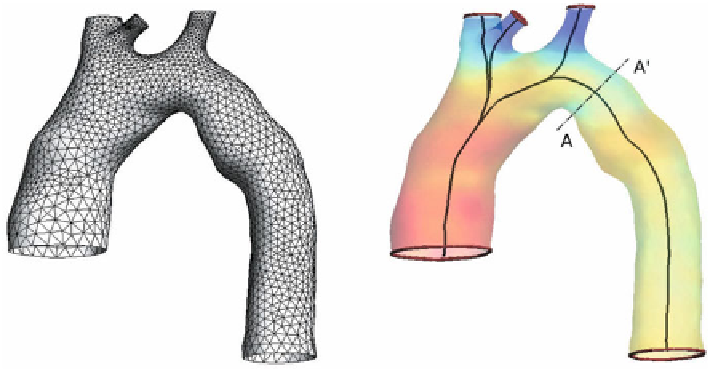Biomedical Engineering Reference
In-Depth Information
The blood flow simulations are performed with the open-source parallel finite
element library LifeV
5
considering first an example with rigid walls, and then one
with compliant walls. The fluid problem is discretized in space using P1-P1 finite
elements stabilized with the interior penalty technique and discretized in time with an
implicit Euler scheme. When considering compliant walls (FSI simulations), the wall
structure is discretized in space with P1 finite elements and in time with a Newmark
second order scheme. The FSI solver relies on a strongly coupled algorithm. More
details on the FSI solver can be found in [12].
Blood is modelled as a Newtonian fluid and if compliant vascular walls are con-
sidered, the wall structure is modelled as a linear elastic material.
13.4.1 Unsteady blood flow in a rigid aortic arch
We study the unsteady blood flow in the same rigid aortic arch. We consider two
different high quality tetrahedral meshes: one with a viscous boundary layer (such as
depicted in yellow in Fig. 13.3) and one fully unstructured. Those two meshes have
the same number of nodes (16
k
) and rely on a quality lumen surface triangulation
that is obtained by remeshing the initial STL triangulation with a mesh size field
h
that is function of the vessel radius
R
(
x
)
(see Fig. 13.7b):
2
π
R
(
x
)
h
(
x
)=
.
(13.11)
20
Fig. 13.7.
Remeshed surface (Left) of the lumen of the aortic arch with a mesh size field
h
that is
function of the vessel radius
R
. The right figure shows the computed centerlines (in black) and the
distance of each surface point
x
to the centerlines, i.e the vessel radius
R
(
x
)
(the color corresponds
to the magnitude of the vessel radius)
5
http://www.lifev.org



